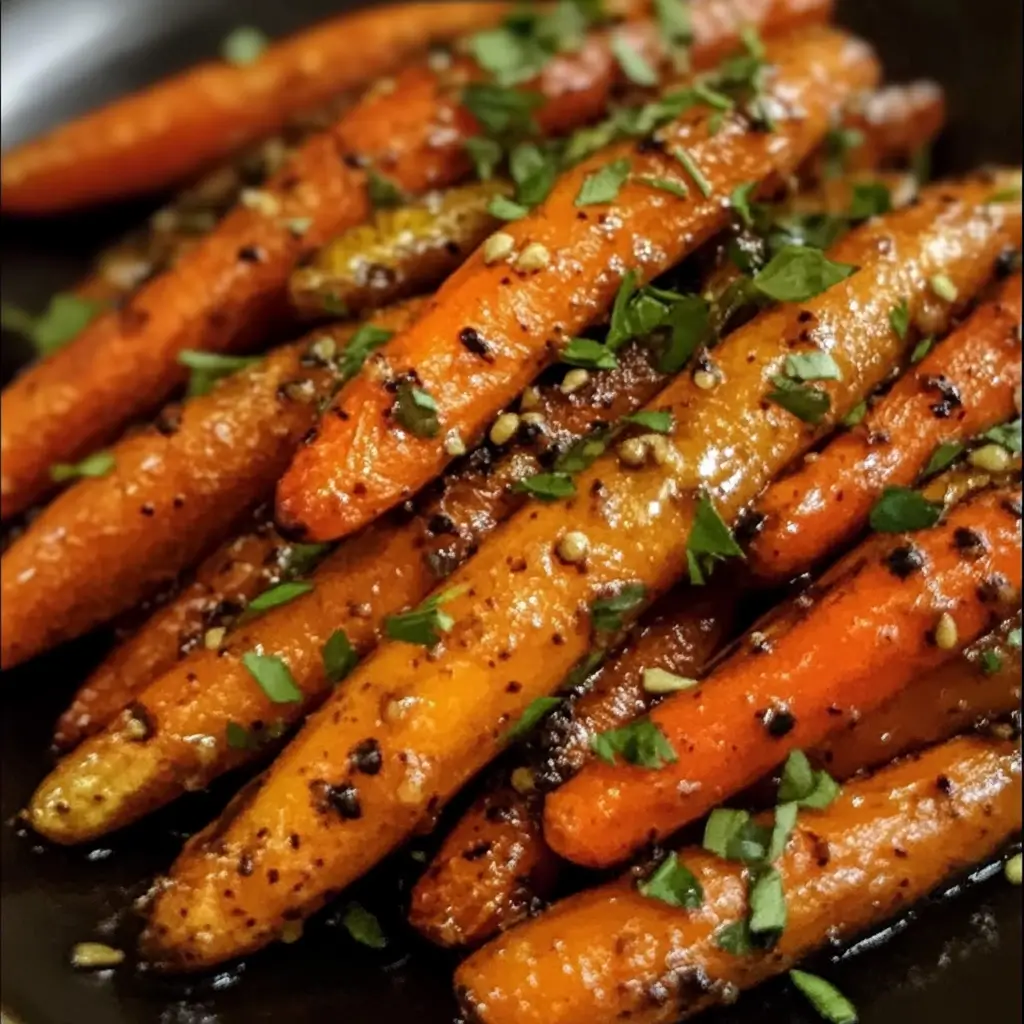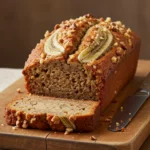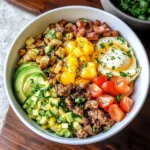In the realm of side dishes, carrots often find themselves relegated to the background, a humble vegetable accompanying more glamorous main courses. However, it’s time to let carrots take center stage, and this Cardamom-Vanilla Bean Glazed Carrots recipe is the perfect vehicle for their delicious transformation. In my own kitchen, this recipe has been nothing short of a revelation. Initially, I was skeptical – vanilla with carrots? Cardamom? It sounded intriguing, but a bit…unconventional. My family, typically carrot-averse beyond the occasional roasted version, were instantly converted. The subtle warmth of cardamom, the delicate sweetness of vanilla, and the natural sweetness of the carrots themselves create a symphony of flavors that is both comforting and surprisingly sophisticated. Even my pickiest eater, my youngest, who usually eyes vegetables with suspicion, devoured these glazed carrots with gusto, proclaiming them “the best carrots ever!” This recipe is not just about making carrots taste good; it’s about elevating them, showcasing their inherent sweetness, and turning them into a dish that’s worthy of any special occasion, or simply a delightful weeknight treat. Prepare to be amazed at how these Cardamom-Vanilla Bean Glazed Carrots can transform your perception of this humble root vegetable.
Ingredients: The Building Blocks of Flavorful Glazed Carrots
The beauty of this Cardamom-Vanilla Bean Glazed Carrots recipe lies in its simplicity, both in technique and ingredients. However, each ingredient plays a crucial role in building the complex and delightful flavor profile that makes this dish so special. Let’s delve into each component, exploring why they are essential and considering potential variations for those adventurous cooks among us.
- Rainbow Carrots (1 pound, about 4-5 medium bunches): The star of our show, rainbow carrots not only offer a visually stunning array of colors – from vibrant orange to deep purple and sunny yellow – but also bring a delightful sweetness and slightly varied flavor profiles to the dish. While classic orange carrots will work perfectly well, opting for rainbow carrots elevates the presentation and adds a touch of elegance. Look for carrots that are firm, smooth, and brightly colored. Smaller to medium-sized carrots are ideal as they cook more evenly and offer a tender-crisp texture.
- Substitution & Variation: If rainbow carrots are unavailable, regular orange carrots are an excellent substitute. You can also experiment with baby carrots for convenience, though they tend to be less flavorful than full-sized carrots. For a rustic touch, consider using heirloom carrots, which come in various shapes and sizes and often boast more intense flavors.
- Unsalted Butter (2 tablespoons): Butter forms the luscious base of our glaze, adding richness, depth of flavor, and a beautiful sheen to the carrots. Unsalted butter is preferred as it allows you to control the overall saltiness of the dish. The fat in the butter also helps to carry the flavors of the cardamom and vanilla, ensuring they coat every carrot piece beautifully.
- Substitution & Variation: For a dairy-free or vegan option, you can substitute unsalted butter with olive oil or coconut oil. Olive oil will impart a slightly fruity and savory note, while coconut oil will add a subtle hint of sweetness and coconut aroma. Vegan butter alternatives also work well, ensuring a similar richness and texture.
- Honey (3 tablespoons): Honey is the sweetening agent in our glaze, providing a natural sweetness that complements the earthy carrots and enhances the warm spices. The floral notes of honey also harmonize beautifully with vanilla and cardamom, creating a well-rounded flavor profile. Choose a good quality honey with a flavor you enjoy, as it will significantly impact the final taste of the glaze.
- Substitution & Variation: For a vegan option, or if you prefer a different sweetener, maple syrup or agave nectar can be used as substitutes for honey. Maple syrup will add a distinct maple flavor that pairs wonderfully with cardamom and vanilla, while agave nectar offers a milder sweetness. You can also experiment with brown sugar or coconut sugar for a richer, molasses-like sweetness.
- Vanilla Bean (1): A true vanilla bean is the secret weapon in this recipe, imparting a depth of vanilla flavor that extract simply cannot replicate. The tiny black seeds within the bean, known as vanilla caviar, are packed with intense aroma and flavor. Splitting and scraping the bean releases these precious seeds, infusing the glaze with a pure and complex vanilla essence.
- Substitution & Variation: While a vanilla bean is highly recommended for the best flavor, vanilla extract can be used in a pinch. Use 1 teaspoon of high-quality pure vanilla extract as a substitute. However, be aware that the flavor will be less nuanced and intense compared to using a fresh bean. For a budget-friendly option, consider using vanilla bean paste, which offers a good balance of flavor and cost-effectiveness.
- Freshly Ground Cardamom (½ teaspoon): Cardamom is the unexpected star spice in this recipe, adding a warm, aromatic, and slightly citrusy note that beautifully complements the sweetness of the carrots and vanilla. Freshly ground cardamom is crucial for the best flavor, as pre-ground cardamom tends to lose its potency quickly. Grind whole cardamom pods just before using for the most vibrant and fragrant spice.
- Substitution & Variation: If you don’t have whole cardamom pods, you can use pre-ground cardamom, but use it sparingly as it can be quite strong. Start with ¼ teaspoon and adjust to taste. For a slightly different spice profile, you could experiment with a pinch of ground ginger or nutmeg, which also pair well with carrots and vanilla.
- Orange Zest (from ½ orange): Orange zest adds a bright, citrusy note that cuts through the sweetness of the glaze and adds a refreshing element to the dish. The aromatic oils in the orange zest enhance the overall flavor complexity and complement both the cardamom and vanilla. Use a microplane or fine grater to zest the orange, ensuring you only get the colored part of the peel and avoid the bitter white pith.
- Substitution & Variation: If orange isn’t your preference, you can substitute it with lemon zest for a slightly tangier flavor, or even lime zest for a more tropical twist. For a different citrus note altogether, consider using grapefruit zest for a slightly bitter and sophisticated edge.
- Fresh Mint Leaves (for garnish): Fresh mint leaves provide a vibrant green color and a refreshing, cooling counterpoint to the warm spices and sweet glaze. The mint’s slightly peppery and sweet flavor complements the carrots and adds a final touch of freshness to the dish. Choose fresh mint leaves that are bright green and fragrant.
- Substitution & Variation: If mint isn’t available or preferred, fresh parsley or cilantro can be used for a similar fresh green garnish. For a nuttier garnish, consider toasted chopped pecans or walnuts instead of pistachios.
- Pistachios (chopped, for garnish): Chopped pistachios add a delightful crunch, a beautiful green color, and a slightly salty and nutty flavor that contrasts nicely with the sweet glaze and tender carrots. Use unsalted roasted pistachios for the best flavor and texture.
- Substitution & Variation: Other nuts that work well as a garnish include toasted almonds, pecans, walnuts, or hazelnuts. For a seed-based crunch, consider toasted pumpkin seeds or sunflower seeds. If you prefer a nut-free option, you can omit the pistachios or use toasted breadcrumbs for texture.
Instructions: Crafting Perfectly Glazed Cardrots Step-by-Step
Making these Cardamom-Vanilla Bean Glazed Carrots is surprisingly straightforward, even for novice cooks. The key is to follow each step carefully and pay attention to the cooking times to achieve perfectly tender-crisp carrots coated in a luscious, flavorful glaze. Let’s break down the process step-by-step:
- Prepare the Carrots: Begin by thoroughly washing and scrubbing the rainbow carrots. Peeling is optional; if you prefer peeled carrots, go ahead and peel them. Trim off the tops and bottoms of the carrots. If using larger carrots, cut them into uniform 2-inch pieces. Smaller carrots can be left whole or halved lengthwise if they are very thick. Uniformity in size is crucial for even cooking.
- Pro-Tip: For visually appealing presentation, consider cutting the carrots into batons (thick sticks) or bias-cut slices (diagonal slices).
- Blanch the Carrots: Blanching is a quick cooking method that partially cooks the carrots while preserving their vibrant color and crisp-tender texture. Bring a large pot of salted water to a rolling boil. Add the prepared carrots to the boiling water and cook for 3-4 minutes, or until they are slightly tender-crisp. They should be easily pierced with a fork but still have a slight bite.
- Why Blanch? Blanching stops the enzyme action that can cause vegetables to lose color and nutrients during cooking. It also ensures that the carrots are cooked through in the glazing process without becoming mushy.
- Perfectly Tender-Crisp: The key to blanched carrots is to avoid overcooking. Test for doneness by piercing a carrot with a fork. It should offer slight resistance but not be completely soft.
- Shock in Ice Water: Immediately transfer the blanched carrots to a bowl of ice water to stop the cooking process. This “shocking” method preserves their vibrant color and crisp texture. Let the carrots cool in the ice water for a few minutes, then drain them thoroughly and pat them dry with paper towels. Drying the carrots is important to ensure the glaze adheres properly.
- Ice Bath Essential: The ice bath is a crucial step in blanching. It prevents carryover cooking and keeps the carrots from becoming overcooked and mushy.
- Prepare the Vanilla Bean: Carefully split the vanilla bean lengthwise using a paring knife. Use the tip of the knife to scrape out the tiny black seeds from inside the bean. Set aside both the vanilla bean pod and the seeds. Don’t discard the pod – it’s packed with flavor and will infuse the glaze beautifully.
- Vanilla Bean Handling: Handle vanilla beans gently as they can be delicate. Splitting the bean lengthwise maximizes the surface area for flavor infusion.
- Make the Cardamom-Vanilla Bean Glaze: Melt the butter in a large skillet over medium heat. Add the honey, vanilla bean seeds, scraped vanilla bean pod, and freshly ground cardamom to the skillet. Stir to combine and bring the mixture to a gentle simmer. Let it simmer for 2-3 minutes, allowing the flavors to meld and infuse into the glaze.
- Gentle Simmer: Avoid boiling the glaze vigorously, as this can cause the honey to crystallize. A gentle simmer is sufficient to infuse the flavors.
- Aromatic Infusion: As the glaze simmers, you’ll notice the delightful aroma of vanilla and cardamom filling your kitchen.
- Glaze the Carrots: Add the blanched and dried carrots to the skillet with the glaze. Toss gently to coat the carrots evenly with the glaze. Cook, stirring occasionally, for 5-7 minutes, or until the glaze has thickened slightly and beautifully coats each carrot piece. The carrots should be heated through and glistening with the glaze.
- Even Coating: Ensure every carrot piece is coated in the glaze for maximum flavor. Toss gently to avoid breaking the carrots.
- Glaze Consistency: The glaze should thicken slightly as it cooks down, creating a beautiful, glossy coating on the carrots.
- Finish and Garnish: Remove the skillet from the heat. Discard the vanilla bean pod. Stir in the orange zest, ensuring it’s evenly distributed. Transfer the glazed carrots to a serving dish. Garnish generously with fresh mint leaves and chopped pistachios. Serve immediately and enjoy the delightful flavors and textures.
- Freshness and Presentation: Adding the orange zest at the end preserves its bright flavor. Garnishing just before serving ensures the mint and pistachios are fresh and vibrant.
Nutrition Facts: A Wholesome and Flavorful Side Dish
These Cardamom-Vanilla Bean Glazed Carrots are not only delicious but also offer a good source of vitamins and nutrients. While the glaze adds a touch of sweetness, the base of the dish is wholesome and vegetable-forward.
- Servings: Approximately 6 servings
- Calories per serving (estimated): 150-200 calories (This is an estimate and can vary based on specific ingredients and portion sizes.)
Nutritional highlights (per serving, estimated):
- Vitamins: Carrots are an excellent source of Vitamin A (in the form of beta-carotene), which is crucial for vision, immune function, and cell growth. They also provide Vitamin K and Vitamin C.
- Fiber: Carrots are a good source of dietary fiber, which aids in digestion and promotes gut health.
- Antioxidants: Rainbow carrots, especially purple and red varieties, are rich in antioxidants, which help protect against cell damage.
- Minerals: Carrots contain potassium and manganese.
Note: The addition of honey and butter contributes to the calorie and fat content. Using olive oil or coconut oil instead of butter and reducing the amount of honey can lower the calorie and fat content.
Preparation Time: Quick and Easy from Start to Finish
This recipe is perfect for busy weeknights or when you need a flavorful side dish in a hurry. The preparation is minimal, and the cooking time is relatively short.
- Prep Time: 15 minutes (washing, chopping carrots, zesting orange, preparing vanilla bean)
- Cook Time: 15 minutes (blanching and glazing)
- Total Time: 30 minutes
How to Serve Cardamom-Vanilla Bean Glazed Carrots: Versatile Serving Suggestions
These glazed carrots are incredibly versatile and can be served in a variety of ways, complementing a wide range of main courses and fitting seamlessly into different meal occasions.
- As a Classic Side Dish:
- Pair with roasted chicken, turkey, or pork tenderloin for a comforting and flavorful meal.
- Serve alongside grilled fish or salmon for a lighter and more elegant option.
- Accompany vegetarian main courses like lentil loaf, stuffed bell peppers, or mushroom Wellington.
- Holiday Feasts:
- A delightful addition to Thanksgiving, Christmas, or Easter dinners, offering a sophisticated twist on traditional glazed carrots.
- Their vibrant colors and festive flavors make them a visually appealing and delicious part of a holiday spread.
- Elevated Weeknight Meals:
- Transform a simple weeknight dinner into something special by adding these glazed carrots to your plate.
- They elevate even basic proteins like pan-seared chicken breasts or baked tofu.
- Buffet or Potluck Contribution:
- These glazed carrots are a crowd-pleasing dish that travels well, making them perfect for potlucks or buffet-style gatherings.
- Their vibrant colors and unique flavor will stand out on a buffet table.
- Warm Salad Component:
- Allow the glazed carrots to cool slightly and toss them with mixed greens, crumbled feta cheese, toasted walnuts, and a light vinaigrette for a warm and flavorful salad.
Additional Tips for Perfect Cardamom-Vanilla Bean Glazed Carrots
To ensure your Cardamom-Vanilla Bean Glazed Carrots are a resounding success, here are five additional tips to keep in mind:
- Quality Ingredients Matter: Using high-quality ingredients will significantly impact the final flavor of the dish. Opt for fresh, vibrant rainbow carrots, good quality unsalted butter, pure honey, a fragrant vanilla bean, and freshly ground cardamom. The better the ingredients, the more delicious the outcome.
- Don’t Overcrowd the Skillet: When glazing the carrots, ensure they are in a single layer in the skillet. Overcrowding can lead to steaming instead of glazing, resulting in unevenly cooked carrots and a watery glaze. If necessary, glaze the carrots in batches to ensure proper caramelization and coating.
- Taste and Adjust Seasoning: Before serving, taste the glazed carrots and adjust the seasoning as needed. You may want to add a pinch more salt to balance the sweetness, or a little extra cardamom for a more pronounced spice flavor. Trust your taste buds and make adjustments to personalize the dish to your preference.
- Storage and Reheating: Leftover glazed carrots can be stored in an airtight container in the refrigerator for up to 3 days. To reheat, gently warm them in a skillet over medium-low heat, adding a tablespoon of water or broth if needed to prevent them from drying out. Avoid microwaving, as it can make the carrots mushy.
- Experiment with Spice Variations: While cardamom is the star spice, don’t be afraid to experiment with other warm spices to create your own unique flavor profile. A pinch of ground ginger, nutmeg, or cinnamon can complement the vanilla and carrots beautifully. Start with small amounts and taste as you go to find your perfect spice blend.
FAQ: Your Questions Answered About Cardamom-Vanilla Bean Glazed Carrots
Here are some frequently asked questions to help you confidently make and enjoy these delightful glazed carrots:
Q1: Can I make this recipe ahead of time?
A: While best served fresh, you can blanch the carrots up to a day ahead of time and store them in the refrigerator. The glaze can also be prepared a few hours in advance and gently reheated before adding the carrots. However, for the best texture and flavor, it’s recommended to glaze the carrots just before serving.
Q2: Can I use baby carrots instead of rainbow carrots?
A: Yes, you can use baby carrots for convenience. However, be aware that baby carrots tend to be less flavorful than full-sized carrots. Reduce the blanching time slightly as baby carrots cook faster. Also, consider halving or quartering larger baby carrots to ensure they are a similar size for even glazing.
Q3: I don’t have a vanilla bean. Can I use vanilla extract only?
A: Yes, you can substitute 1 teaspoon of pure vanilla extract for the vanilla bean. Add the vanilla extract to the glaze at the end, after removing it from the heat, to preserve its flavor. While vanilla extract will provide vanilla flavor, it won’t have the same depth and complexity as a fresh vanilla bean.
Q4: Are these glazed carrots vegan?
A: As written, this recipe is not vegan due to the butter and honey. However, it can easily be made vegan by substituting unsalted butter with olive oil or vegan butter and honey with maple syrup or agave nectar. These substitutions will maintain the delicious flavor profile while making the dish plant-based.
Q5: Can I add other vegetables to this glaze?
A: While this glaze is specifically designed to complement carrots, you can experiment with other root vegetables like parsnips, sweet potatoes, or even butternut squash. Adjust the cooking time accordingly depending on the density of the vegetable. Consider roasting denser vegetables like butternut squash before glazing them for optimal texture.
Print
Cardamom-Vanilla Bean Glazed Carrots Recipe
Ingredients
- Rainbow Carrots (1 pound, about 4-5 medium bunches): The star of our show, rainbow carrots not only offer a visually stunning array of colors – from vibrant orange to deep purple and sunny yellow – but also bring a delightful sweetness and slightly varied flavor profiles to the dish. While classic orange carrots will work perfectly well, opting for rainbow carrots elevates the presentation and adds a touch of elegance. Look for carrots that are firm, smooth, and brightly colored. Smaller to medium-sized carrots are ideal as they cook more evenly and offer a tender-crisp texture.
- Substitution & Variation: If rainbow carrots are unavailable, regular orange carrots are an excellent substitute. You can also experiment with baby carrots for convenience, though they tend to be less flavorful than full-sized carrots. For a rustic touch, consider using heirloom carrots, which come in various shapes and sizes and often boast more intense flavors.
- Unsalted Butter (2 tablespoons): Butter forms the luscious base of our glaze, adding richness, depth of flavor, and a beautiful sheen to the carrots. Unsalted butter is preferred as it allows you to control the overall saltiness of the dish. The fat in the butter also helps to carry the flavors of the cardamom and vanilla, ensuring they coat every carrot piece beautifully.
- Substitution & Variation: For a dairy-free or vegan option, you can substitute unsalted butter with olive oil or coconut oil. Olive oil will impart a slightly fruity and savory note, while coconut oil will add a subtle hint of sweetness and coconut aroma. Vegan butter alternatives also work well, ensuring a similar richness and texture.
- Honey (3 tablespoons): Honey is the sweetening agent in our glaze, providing a natural sweetness that complements the earthy carrots and enhances the warm spices. The floral notes of honey also harmonize beautifully with vanilla and cardamom, creating a well-rounded flavor profile. Choose a good quality honey with a flavor you enjoy, as it will significantly impact the final taste of the glaze.
- Substitution & Variation: For a vegan option, or if you prefer a different sweetener, maple syrup or agave nectar can be used as substitutes for honey. Maple syrup will add a distinct maple flavor that pairs wonderfully with cardamom and vanilla, while agave nectar offers a milder sweetness. You can also experiment with brown sugar or coconut sugar for a richer, molasses-like sweetness.
- Vanilla Bean (1): A true vanilla bean is the secret weapon in this recipe, imparting a depth of vanilla flavor that extract simply cannot replicate. The tiny black seeds within the bean, known as vanilla caviar, are packed with intense aroma and flavor. Splitting and scraping the bean releases these precious seeds, infusing the glaze with a pure and complex vanilla essence.
- Substitution & Variation: While a vanilla bean is highly recommended for the best flavor, vanilla extract can be used in a pinch. Use 1 teaspoon of high-quality pure vanilla extract as a substitute. However, be aware that the flavor will be less nuanced and intense compared to using a fresh bean. For a budget-friendly option, consider using vanilla bean paste, which offers a good balance of flavor and cost-effectiveness.
- Freshly Ground Cardamom (½ teaspoon): Cardamom is the unexpected star spice in this recipe, adding a warm, aromatic, and slightly citrusy note that beautifully complements the sweetness of the carrots and vanilla. Freshly ground cardamom is crucial for the best flavor, as pre-ground cardamom tends to lose its potency quickly. Grind whole cardamom pods just before using for the most vibrant and fragrant spice.
- Substitution & Variation: If you don’t have whole cardamom pods, you can use pre-ground cardamom, but use it sparingly as it can be quite strong. Start with ¼ teaspoon and adjust to taste. For a slightly different spice profile, you could experiment with a pinch of ground ginger or nutmeg, which also pair well with carrots and vanilla.
- Orange Zest (from ½ orange): Orange zest adds a bright, citrusy note that cuts through the sweetness of the glaze and adds a refreshing element to the dish. The aromatic oils in the orange zest enhance the overall flavor complexity and complement both the cardamom and vanilla. Use a microplane or fine grater to zest the orange, ensuring you only get the colored part of the peel and avoid the bitter white pith.
- Substitution & Variation: If orange isn’t your preference, you can substitute it with lemon zest for a slightly tangier flavor, or even lime zest for a more tropical twist. For a different citrus note altogether, consider using grapefruit zest for a slightly bitter and sophisticated edge.
- Fresh Mint Leaves (for garnish): Fresh mint leaves provide a vibrant green color and a refreshing, cooling counterpoint to the warm spices and sweet glaze. The mint’s slightly peppery and sweet flavor complements the carrots and adds a final touch of freshness to the dish. Choose fresh mint leaves that are bright green and fragrant.
- Substitution & Variation: If mint isn’t available or preferred, fresh parsley or cilantro can be used for a similar fresh green garnish. For a nuttier garnish, consider toasted chopped pecans or walnuts instead of pistachios.
- Pistachios (chopped, for garnish): Chopped pistachios add a delightful crunch, a beautiful green color, and a slightly salty and nutty flavor that contrasts nicely with the sweet glaze and tender carrots. Use unsalted roasted pistachios for the best flavor and texture.
- Substitution & Variation: Other nuts that work well as a garnish include toasted almonds, pecans, walnuts, or hazelnuts. For a seed-based crunch, consider toasted pumpkin seeds or sunflower seeds. If you prefer a nut-free option, you can omit the pistachios or use toasted breadcrumbs for texture.
Instructions
- Prepare the Carrots: Begin by thoroughly washing and scrubbing the rainbow carrots. Peeling is optional; if you prefer peeled carrots, go ahead and peel them. Trim off the tops and bottoms of the carrots. If using larger carrots, cut them into uniform 2-inch pieces. Smaller carrots can be left whole or halved lengthwise if they are very thick. Uniformity in size is crucial for even cooking.
- Pro-Tip: For visually appealing presentation, consider cutting the carrots into batons (thick sticks) or bias-cut slices (diagonal slices).
- Blanch the Carrots: Blanching is a quick cooking method that partially cooks the carrots while preserving their vibrant color and crisp-tender texture. Bring a large pot of salted water to a rolling boil. Add the prepared carrots to the boiling water and cook for 3-4 minutes, or until they are slightly tender-crisp. They should be easily pierced with a fork but still have a slight bite.
- Why Blanch? Blanching stops the enzyme action that can cause vegetables to lose color and nutrients during cooking. It also ensures that the carrots are cooked through in the glazing process without becoming mushy.
- Perfectly Tender-Crisp: The key to blanched carrots is to avoid overcooking. Test for doneness by piercing a carrot with a fork. It should offer slight resistance but not be completely soft.
- Shock in Ice Water: Immediately transfer the blanched carrots to a bowl of ice water to stop the cooking process. This “shocking” method preserves their vibrant color and crisp texture. Let the carrots cool in the ice water for a few minutes, then drain them thoroughly and pat them dry with paper towels. Drying the carrots is important to ensure the glaze adheres properly.
- Ice Bath Essential: The ice bath is a crucial step in blanching. It prevents carryover cooking and keeps the carrots from becoming overcooked and mushy.
- Prepare the Vanilla Bean: Carefully split the vanilla bean lengthwise using a paring knife. Use the tip of the knife to scrape out the tiny black seeds from inside the bean. Set aside both the vanilla bean pod and the seeds. Don’t discard the pod – it’s packed with flavor and will infuse the glaze beautifully.
- Vanilla Bean Handling: Handle vanilla beans gently as they can be delicate. Splitting the bean lengthwise maximizes the surface area for flavor infusion.
- Make the Cardamom-Vanilla Bean Glaze: Melt the butter in a large skillet over medium heat. Add the honey, vanilla bean seeds, scraped vanilla bean pod, and freshly ground cardamom to the skillet. Stir to combine and bring the mixture to a gentle simmer. Let it simmer for 2-3 minutes, allowing the flavors to meld and infuse into the glaze.
- Gentle Simmer: Avoid boiling the glaze vigorously, as this can cause the honey to crystallize. A gentle simmer is sufficient to infuse the flavors.
- Aromatic Infusion: As the glaze simmers, you’ll notice the delightful aroma of vanilla and cardamom filling your kitchen.
- Glaze the Carrots: Add the blanched and dried carrots to the skillet with the glaze. Toss gently to coat the carrots evenly with the glaze. Cook, stirring occasionally, for 5-7 minutes, or until the glaze has thickened slightly and beautifully coats each carrot piece. The carrots should be heated through and glistening with the glaze.
- Even Coating: Ensure every carrot piece is coated in the glaze for maximum flavor. Toss gently to avoid breaking the carrots.
- Glaze Consistency: The glaze should thicken slightly as it cooks down, creating a beautiful, glossy coating on the carrots.
- Finish and Garnish: Remove the skillet from the heat. Discard the vanilla bean pod. Stir in the orange zest, ensuring it’s evenly distributed. Transfer the glazed carrots to a serving dish. Garnish generously with fresh mint leaves and chopped pistachios. Serve immediately and enjoy the delightful flavors and textures.
- Freshness and Presentation: Adding the orange zest at the end preserves its bright flavor. Garnishing just before serving ensures the mint and pistachios are fresh and vibrant.
Nutrition
- Serving Size: One Normal Portion
- Calories: 150-200





